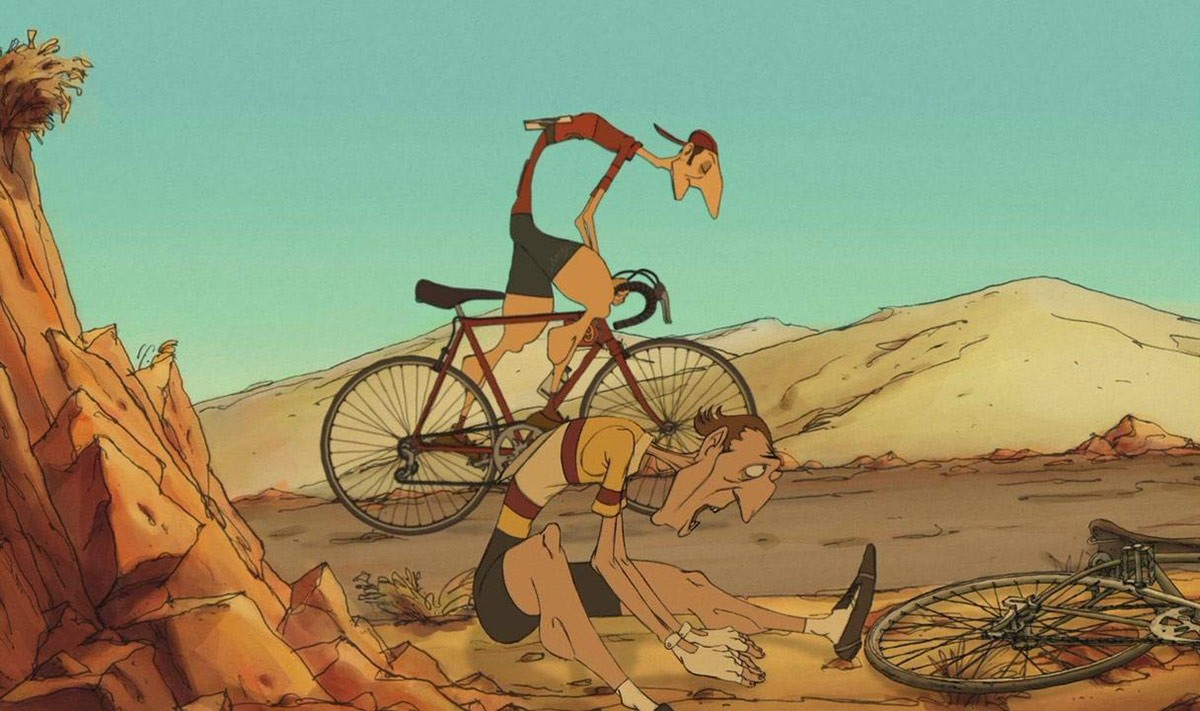The
Triplets of Belleville is
Sylvain Chomet’s 2003 animated film, which follows some rather unique yet
appealing characters on a bizarre journey. With very little dialogue, the
audience are shown the life of Madame Souza, an elderly woman living in France.
With her, lives her grandson Champion, who is training to race in the Tour de
France, and their loyal dog, Bruno. After being introduced to these characters
and their daily training routine of cycling around the city, it paints a rather
lifeless picture of their everyday lives, with the characters not showing much
emotion or excitement, which can also be also be due to the lack of dialogue.
Nevertheless, the glimpses of what they each get up to is charmingly
representative of interesting character and everyday life, not forgetting Bruno,
the overweight dog that spends his days barking at passing trains without
fail. While a series of bizarre events unfold one after another, Madame
Souza finds herself uniting with the elderly Triplets of Belleville (who were
once a famous singing trio) in order to rescue her son from the French Mafia,
after they kidnap him and a few other racers during the Tour de France race.
Despite the film’s unconcern to capture perfection and beauty in the characters attractiveness, the same cannot be said for the animation, which in itself is masterfully detailed and so elaborate that it captures the illusion of life incredibly. Although the world isn’t outrageously upbeat and positive, it doesn’t lack appeal, and that is probably thanks to the impressive craft of animation, which gives this world the ability to stand out so strongly and grasp the audience so tightly. “The animation itself is superbly detailed and vividly eccentric, and as for the story - it’s impossible to tell if it’s a children’s story for adults or an adult’s story for children. Or if it matters.” (Bradshaw, 2003)

| Figure. 1. The Triplets of Belleville film poster. |
The
film has a sombre tone, both with the Mise en scène, in addition to the lack of
speech and expression of happiness, which sets the mood of the environment and
world solidly. “Most animated features have an almost grotesque desire to be
loved. This one doesn’t seem to care. It creates a world of selfishness,
cruelty, corruption and futility — but it’s not serious about this world and it
doesn’t want to attack it or improve upon it. It simply wants to sweep us up in
its dark comic vision.” (Ebert, 2003)
Although
the story itself is wacky and extraordinary, the film is still very appealing
and captures real life familiarity in character exceedingly well. The film
succeeds at capturing not the beauty within individual characters, but the
ugliness of them, caricaturing their features, and having each character embody
this exaggeration of real life personality that we see around us everyday, but
seem to forget about a lot, as it can easily become lost within most animation
and film, in the process of trying to capture cuteness and attractiveness in
characters. Whilst this film isn’t particularly realistic looking, it certainly
does go after the details of character and essence of everyday life, ironically
creating the humour through the un-attractiveness that we recognise in the real
world every day. “Chomet demonstrates a remarkable ability to signify the
touchingly human without suffocating the rest of the work in crippling, syrupy
Disney-esque overtness that overwhelms so many American animated films.”
(Vasquez & Gonzalez, 2004)
 |
| Figure. 2. The Triplets of Belleville film still. |
Despite the film’s unconcern to capture perfection and beauty in the characters attractiveness, the same cannot be said for the animation, which in itself is masterfully detailed and so elaborate that it captures the illusion of life incredibly. Although the world isn’t outrageously upbeat and positive, it doesn’t lack appeal, and that is probably thanks to the impressive craft of animation, which gives this world the ability to stand out so strongly and grasp the audience so tightly. “The animation itself is superbly detailed and vividly eccentric, and as for the story - it’s impossible to tell if it’s a children’s story for adults or an adult’s story for children. Or if it matters.” (Bradshaw, 2003)
Illustration List
Figure.1. Rotten Tomatoes, The Triplets of Belleville film poster. https://www.rottentomatoes.com/m/the_triplets_of_belleville [Accessed 30/04/19]
Figure. 2. Cartoon Brew, The Triplets of Belleville film still. https://www.cartoonbrew.com/feature-film/the-triplets-of-belleville-15th-anniversary-7-insights-into-the-making-of-a-contemporary-classic-159630.html [Accessed 30/04/19]
Bibliography
Bradshaw P. (2003) https://www.theguardian.com/film/News_Story/Critic_Review/Guardian_review/0,4267,1030893,00.html [Accessed 30/04/19]
Ebert
R. (2003) https://www.rogerebert.com/reviews/the-triplets-of-belleville-2003 [Accessed
30/04/19]
Vasquez
J & Gonzalez E. (2004) https://www.google.co.uk/amp/s/www.slantmagazine.com/dvd/the-triplets-of-belleville/amp/ [Accessed
30/04/19]
Comments
Post a Comment